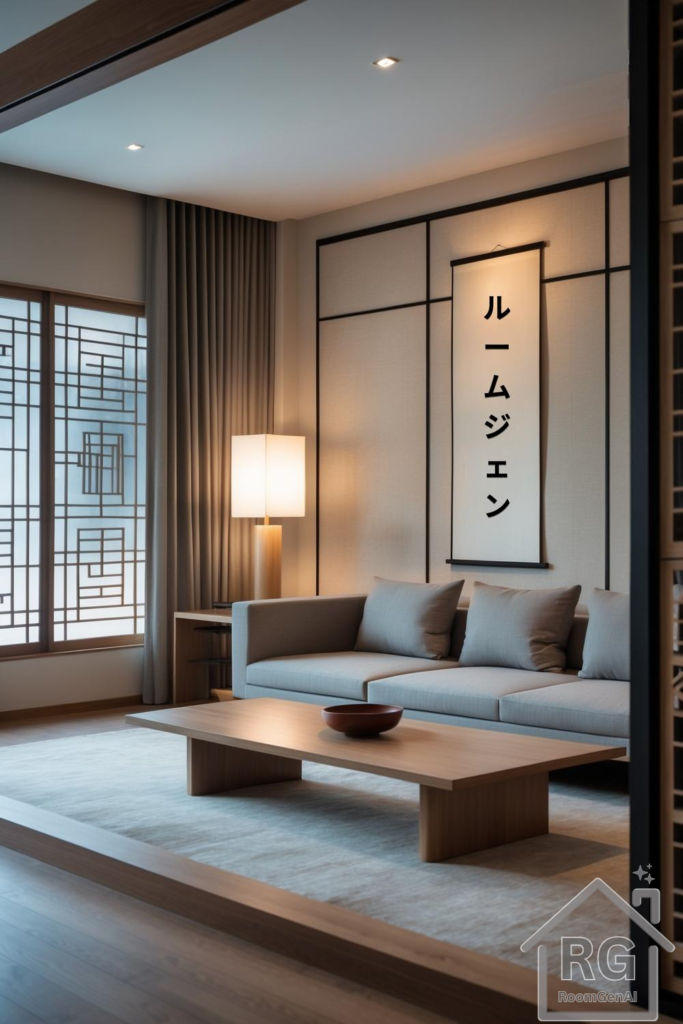
(Color Palette Disclaimer: The color palette referenced here is approximate and may vary based on screen settings and printing methods. Always test paint swatches and fabrics in your space before making final decisions.)
(Affiliate Disclosure: Some of the links in this post may be affiliate links, which means I may earn a small commission if you make a purchase through them—at no extra cost to you. Thank you for supporting my work and helping me continue to provide free content!)
Modern Japanese interior design is all about simplicity, balance, and harmony with nature. By combining clean lines, subtle color palettes, and thoughtful decor, you can achieve a space that feels both minimalist and inviting. Below, you’ll find key elements for creating a Japanese-style living room that resonates with serenity—perfect for unwinding after a busy day or welcoming guests into a calming environment.
1. Embrace a Neutral, Earth-Toned Palette
In Japanese design, muted earth tones and neutrals evoke a sense of calm and understated elegance. Light beige, soft grays, and warm browns set the backdrop for the room, allowing wooden features and subtle accents to shine. If you want a small pop of color, consider introducing gentle greens or muted blues through pillows or decorative items. The goal is to maintain a cohesive look that mirrors the tranquil qualities of nature.
2. Choose Minimalist Furniture
Less is more when it comes to Japanese-style furniture. Low-profile pieces, such as a simple platform sofa or a low coffee table, help create an open feel. Focus on functionality: items should serve a clear purpose without unnecessary embellishments. Opt for clean lines, high-quality wood, and neutral upholstery to keep the aesthetic cohesive. If you’re short on space, consider multi-functional furniture like benches with hidden storage or nesting side tables.
3. Incorporate Sliding Screens and Subtle Dividers
Traditional Japanese homes often use shoji screens—translucent panels that allow light to pass through while maintaining privacy. Even if you can’t install authentic shoji, you can achieve a similar effect with modern sliding doors or minimalist room dividers. These features not only partition spaces in a flexible way but also introduce an elegant architectural element that reinforces the Japanese vibe. For added authenticity, look for screens with wooden frames and rice paper-like materials.
4. Focus on Natural Materials
In a modern Japanese-style living room, materials like wood, bamboo, and natural fibers take center stage. Hardwood floors or tatami mats can provide a tactile connection to nature underfoot. A wooden coffee table or side table can become a focal point, especially if it showcases a unique grain pattern. Soften these harder surfaces with cushions, area rugs, or throw blankets in neutral tones. This blend of textures offers comfort while honoring minimalism.
- Bamboo Accents: Try bamboo trays or planters for a sustainable, organic feel.
- Textiles: Consider linen or cotton for curtains and pillow covers to maintain breathability and simplicity.
5. Add Thoughtful Decor and Greenery
While Japanese design is minimalist, a few carefully chosen decorative pieces can lend personality. Hang a simple wall scroll or calligraphy artwork that resonates with your style. Introduce potted plants—like bonsai or bamboo—to bring nature indoors. These touches remind you to slow down and appreciate the room’s tranquil qualities. If you have space, a small alcove or tokonoma can be used to display a single piece of art or a floral arrangement, focusing attention on the beauty of one item at a time.
By blending minimalism, natural materials, and cultural accents, you can create a modern Japanese-style living room that exudes calm and harmony. The key lies in selecting pieces and colors that celebrate simplicity, while leaving enough open space to breathe. Whether you’re sipping tea, reading a book, or hosting friends, a carefully curated Japanese-inspired setting can transform your everyday living area into a serene retreat.
